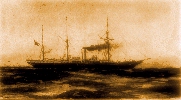

Spain was one of the few countries that had specially-constructed hydrographic vessels. Spain understood the need for good hydrographic research. By order of the Spanish navy Department one vessel was to operate off Spain (VULCANO, later repalced in 1895 by URANIA), one vessel was sent to Cuba (CRIOLLO), and one vessel was sent to the Philippines (ARGOS). Each vessel was required to be armed in case they had to function as a gunboat..
The author is searching for more information on these vessels, and
would like verification of the facts as listed below. If you can in
either of these items, please contact the website
administrator, and he will put us in contact! We need your help!
|
|
|
|
|
|
|
|
|
|
|
|
|
|
|
|
The vessel served in the North Naval Squadron. From 1848 to 1859, she served as a coastal patrol vessel and then in the African Squadron during the war against Morocco. From 1861 to 1862, she served in the Instructional Squadron and then again as a coastal patrol vessel. During the 3rd Carlist War VULCANO served in the Mediterranean Squadron. From 1876 to 1889, she again served as a coastal patrol vessel. From 1889 to 1897 she served as a hydrographic vessel
The vessel was named for the Roman god of fire.
|
|
|
|
|
|
|
|
|
|
|
|
|
|
|
|
The iron-hulled vessel was built for service in the Philippines, but the details of her service are unknown. During the Battle of Manila Bay/Cavite, she was close to the Spanish Squadron, but was not engaged in the battle. She was hit once in the battle, with little damage. In accordance with Admiral Montojo's orders, after the battle she retired into Canacao Bay and was scuttled. Later, after the conclusion of the battle a landing party from the USS PETREL set fire to her and destroyed her.
The vessel was named for the vessel of the Argonauts in Greek mythology.

|
|
|
|
|
|
|
|
|
|
|
|
|
|
|
|
The vessel was built to replace the old VULCANO. The details of her career is unknown. She was on the rolls of the Spanish Navy into the 1930's.
The vessel was named for the Greek God of astronomy.
Diaz Diaz, Francisco Jose, (personal correspondence)
Mitiuckov, Nick, Naval Historian, Izhevsk, Russia (personal correspondence)